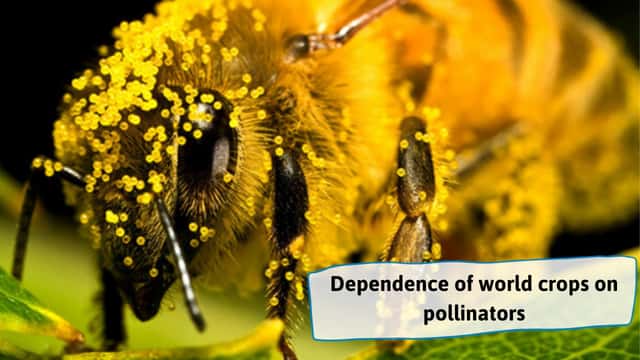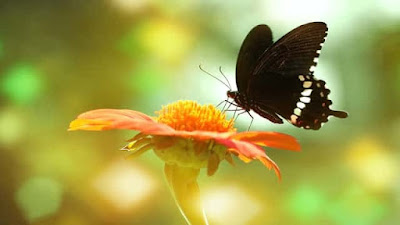- Get link
- X
- Other Apps
- Get link
- X
- Other Apps
 |
What are Pollinators?
Pollinators are animals that move pollen from the male structure (anthers) of the flowers to the female structure (stigma) of the same plant species.
The movement of pollen (analogous to sperm) to the stigma of the flower results in the fertilization of the eggs of the flower.
A properly fertilized flower will produce seeds and fruit surrounding the seeds, ensuring that a new generation of plants can be grown.
The role of pollinators is, among other things, to ensure reproduction, fruit setting, and plant dispersion, both in agroecosystems and in natural ecosystems.
The movement of pollen (analogous to sperm) to the stigma of the flower results in the fertilization of the eggs of the flower.
A properly fertilized flower will produce seeds and fruit surrounding the seeds, ensuring that a new generation of plants can be grown.
The role of pollinators is, among other things, to ensure reproduction, fruit setting, and plant dispersion, both in agroecosystems and in natural ecosystems.
Pollination helps both the plants and the pollinators. Pollination results in the production of seeds and is necessary for the reproduction of many plants.
Pollinators have different characteristics and reactions to different temperatures and habitats, which means that we have pollinators suitable for different climates.
Their diversity not only ensures pollination for current conditions but also for future ones.
Although pollinators play a key role in the production of more than 75% of the crops.
There has been a massive decline in their population, in particular bees and butterflies, mainly due to unsustainable farming practices and the use of harmful pesticides.
Honey bees, other bee species, animals, butterflies, beetles, flies, some birds, and some bats.
What is Pollination?
Pollination is the transfer of pollen from a male part of a plant to a female part of a plant. Eventually, it enables the fertilization and production of seeds, most often by wind or animals.Pollinating agents are animals such as insects, birds, and bats; water; wind; and even plants themselves, where self-pollination occurs within a closed flower.
When pollination occurs between species, hybrid offspring may be produced in nature and plant breeding.
Facts:
- Insects are the creatures that do run the world and they are wonderful.
- Insects are responsible for a lot of pollination of food crops.
- Two-thirds of the flowering plants on the planet are pollinated by insects.
Bee diversity
Bee diversity is a really interesting Cline which is a trend in terms of populations and diversity in that it is that they aren't more diverse in tropical rainforests.The forests do have a lot of diversity but interestingly enough it's the deserts and the drylands of the world where most of the bees are found.
Bees pollinate crops and wildflowers; in other words, they are pollinating.
Healthy pollinators and healthy ecosystems
Plants are the foundation of food chains on earth. Plants provide shelter and nesting habitat for many different species of animals.Therefore, to preserve the diversity of our natural habitats, we need healthy populations of pollinators to ensure the production of the next generation of plants.
Dependence of world crops on pollinators
Of the 115 crops whose pollen vectors have been identified in a recent global study, more than 75% depends to some degree on animal pollination. Moreover, they need to be a focus on that.
Among the leading crops that benefit from animal pollination, 13 are entirely dependent on animal pollinators, 30 are highly dependent and 27 are moderately dependent.
Among the leading crops that benefit from animal pollination, 13 are entirely dependent on animal pollinators, 30 are highly dependent and 27 are moderately dependent.
Economic valuation of the vulnerability of world agriculture confronted with pollinator decline
There is increasing evidence of a worldwide decline in pollinators, and the consequences in many agricultural areas could be significant.We assessed these consequences by measuring:
- The contribution of insect pollination to the economic value of world agricultural output.
- he vulnerability of world agriculture to the decline of pollinators.
Why bees are disappearing?
Bees are dying from multiple and interacting causes, bees dying reflects a flowerless landscape and a dysfunctional food system- after World War II, we started using herbicides to kill off the weeds in our farms.Similarly, these will definitely be going to affect in the long run to humans Above all, many of these weeds are flowering plants that bees require for their survival.
Main causes:
- Artificial Food Substitutes
- Artificial Insemination
- Monocultures
- Pesticides
- Synergy
How can we contribute?
In conclusion, Plant bee-friendly flowers, and we should not contaminate these flowers with pesticides.
Campaign to plant them in public gardens and community spaces
For our bees, but also migratory butterflies and birds and other animals, we need roadsides planted with flowers.
When bees have access to good nutrition, their pollination services give us access to good nutrition.
For more amazing Articles click below :
bee pollinators
covid19
cross pollination
currentaffairs
education
insect pollination
pollination
pollinators
self pollination
types of pollination
wasps pollinate
what is pollination
- Get link
- X
- Other Apps
Comments





Nice article
ReplyDeleteWithout pollinators many food we love could disappear!